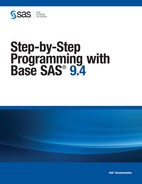Customizing Your Current Session
Ways to Customize
Customizing SAS Sessions and Programs at Start-up
Setting Invocation-Only Options Automatically
You can specify some system options
only when you invoke SAS. These system options affect the following:
Note: There are other system options
that you can specify at any time. For more information,
see Customizing with SAS System Options.
Usually, any invocation-only
options are set by default when SAS is installed at your site. However,
you can specify invocation-only options on the command line each time
you invoke SAS.
To avoid having to specify
options that you use every time you run SAS, set the options in a
configuration file. Each time you invoke SAS, SAS looks for that file
and uses the customized settings that it contains. Be sure to examine
the default configuration file before creating your own.
Executing SAS Statements Automatically
Just as you can
set SAS system options automatically when you invoke SAS, you can
also execute statements automatically when you invoke SAS by creating
a special autoexec file. Each time you invoke SAS, it looks for this
special file and executes any of the statements that it contains.
Customizing with SAS System Options
Using the OPTIONS Statement and the Options Window
SAS system options determine global SAS settings. For
example, the global options can affect the following:
The previous section
discusses some invocation-only options that must be set at start-up.
However, there are many system options that can be set at any time.
These system options can be set in an OPTIONS statement as well as
in the Options window.
It is important to note
that system option settings remain in effect until you change them
again, or until your current session ends.
There
are several ways to view your system option settings. The two most
common methods are the following:
To obtain a complete list of system option settings
using the OPTIONS procedure, submit the following statements:
proc options; run;
The Options window
groups options by function. The left side of the window includes a
tree that lists the available option groups. You can expand option
groups to see subgroups.
..................Content has been hidden....................
You can't read the all page of ebook, please click here login for view all page.

